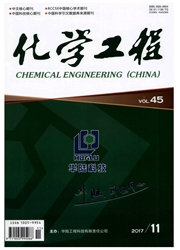

 中文摘要:
中文摘要:
基于中间再沸器的热泵精馏是常规热泵的新拓展,可以推广应用于大温差精馏体系。将该技术应用于氯化苄的侧反应器/精馏塔耦合工艺,建立了其基于中间再沸器的热泵精馏新流程。采用理想热力学模型计算相平衡,等熵压缩模型模拟压缩机,运用数值处理软件Matlab,基于Newton-Raphson法对氯化苄的热泵精馏工艺进行了模拟计算,考察了关键参数对精馏过程能耗的影响,得出了适宜的工艺操作条件。结果表明:当中间再沸器安装于第7与第8块塔板间,最小传热温差为10 K,换热量为90 k W时,过程能耗较低。在工艺主体结构与分离任务相同的情况下,与基础工艺相比,热泵精馏工艺可节约年操作费用31.0%,年度总费用17.0%。
 英文摘要:
英文摘要:
Direct vapor recompression heat pump distillation system with intermediate reboiler, proposed as an advanced heat pumping technology, can be applied in the cases, which is relatively large temperature difference between the overhead and the bottom in the column. This technology was then applied in the synthesis system of benzyl chloride of the coupled side-reactor/column process, and a novel heat pumping flowsheet assisted by the intermediate reboiler was correspondingly set up. With the ideal thermodynamic model to describe the phase equilibrium and the isentropic compression model to represent the compressor, the heat pumping technique was simulated based on Newton-Raphson method in Matlab software. Besides, the effects of the key variables on the energy consumption for distillation were investigated to get the suitable values. The results show that, the better energy-saving efficiency can be obtained under the conditions that the intermediate reboiler is located at stage 7 and 8, and the heat transferred rate of the intermediate reboiler is 90 kW under the given minimum temperature difference of 10 K. Compared with the basic process, the annual operation cost is declined by 31.0% and the total annual cost is decreased by 17.0% in the heat pumping process at the same configuration and system performance.
 同期刊论文项目
同期刊论文项目
 同项目期刊论文
同项目期刊论文
 期刊信息
期刊信息
